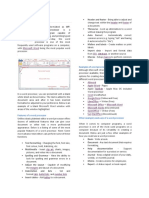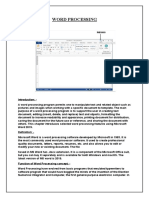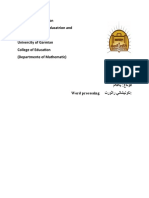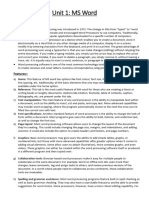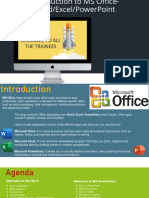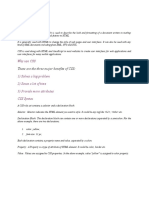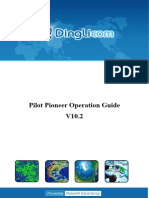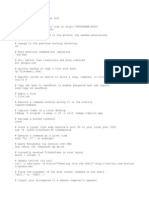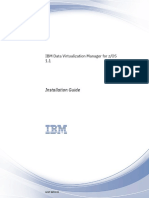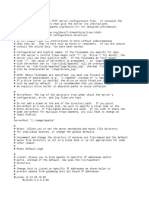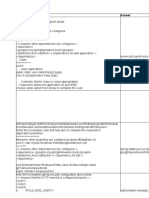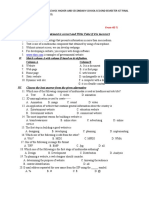Word Processing Notes
Introduction to Word Processing
What Is a Word Processor?
Programs that required several other machines – keyboards, monitors, disks, computers, and
printers – to create documents.
Give users the ability to:
• Correct your work before printing.
• Check for spelling and grammar errors.
• Verify the meanings of words and synonyms by using the thesaurus.
• Transfer text between documents.
• Format text with various fonts, sizes and styles.
• Format pages instantly with structural styles, such as lists, tables, paragraphs, and
headings
The Beginning of the Word Processor
1. Started with users writing by hand on different kinds of paper
2. Then, the first printing press was introduced
3. Next, came the invention of the typewriter
4. Finally, in the 1970s the word processor was introduced
Creating Documents
Users can easily create pre-made documents using a:
• template - provides a page design layout into which you can place your content.
• Allows you to enter your own text and images.
• Or you can start with a blank document
Popular software applications which allow you to create documents are Microsoft Word and
Google Docs (cloud-based)
Storing Your Documents
To the Cloud:
• Provides accessibility to your documents from anywhere you can obtain an internet
connection.
• Provides connectivity from your computer, smartphone or tablet – through downloaded apps
for mobile devices.
To the Computer:
• Provides a physical location to store documents to a hard drive
• Provides exclusive access to information on your computer anytime
• Not vulnerable to unsecure documents being hacked or stolen
ITEC 5
IT Application Tools in Business
� Word Processing Notes
Cloud Computing
To understand Cloud computing, you must first know what the “cloud” is?
• The cloud is a wide network of data centers (made up of large storage computers called file
servers) throughout the world that can store your information and retrieve it for you from
anywhere you can obtain an Internet connection.
• Cloud Computing tools that are used and accessed exclusively over the Internet rather than
installed on a single computer.
Getting Started with Word Processing
When opening a new document in Google Docs, there is a menu of commonly used commands:
• File - Share, New, Open, Rename, Make a Copy, Move to Trash, See Revision History, See New
Changes, Language, Download as, Publish to Web, E-Mail Collaborators, Page Setup, Print
• Edit - Undo, Redo, Cut, Copy, Paste, Web Clipboard, Select All, Find and Replace
• View - Print Layout, Mode (Editing, Suggesting, Viewing), Show Ruler, Show Equation
Toolbar, Show Spelling Suggestions, Compact Controls, Full Screen
• Insert - Image, Link, Equation, Drawing, Table, Comment, Footnote, Special Characters,
Horizontal Line, Page Number, Page Count, Page Break, Header, Footer, Table of Contents
• Format - Bold, Italic, Underline, Strikethrough, Superscript, Subscript, Font Size,
Paragraph Styles, Align, Line Spacing, Lists, Clear Formatting, Lines, Crop Image, Image
Options, Replace Image, Reset Image, Alt Text
• Tools - Spelling, Research, Define, Word Count, Voice Typing, Translate Document, Script
Editor, Preferences, Personal Dictionary
• Table - Insert Table, Insert row above, Insert row below, Insert Column Left, Insert Column
Right, Delete Row, Delete Column, Delete Table, Merge Cells, Unmerge Cells, Table Properties
• Add ons - Get Add-ons, Manage Add-ons
• Help - Search Menus for Assistance, Docs Help, Report a Problem, Report
abuse/copyright, Keyboard Shortcuts
Common Commands in Microsoft Word
When opening a new document in Microsoft Word, there is a menu of commonly used
commands:
• File - Info, New, Open, Save, Save As, Save as Adobe PDF, Print, Share, Export, Close, Account,
Options, Add-ins
• Home - Clipboard, Font, Paragraph, Styles, Editing
• Insert - Pages, Tables, Illustrations, Add-ins, Media, Links, Comments, Header & Footer, Text,
Symbols, Flash
• Design - Document Formatting, Page Background
• Page Layout - Page Setup, Paragraph, Arrange
ITEC 5
IT Application Tools in Business
� Word Processing Notes
• References - Table of Contents, Footnotes, Citations & Bibliography, Captions, Index, Table
of Authorities
• Mailings - Create, Start Mail Merge, Write & Insert Fields, Preview Results, Finish
• Review - Proofing, Language, Comments, Tracking, Changes, Compare, Protect, Ink
• View - Views, Show, Zoom, Window, Macros
Keyboard Shortcuts
Some common commands are used in word processing to save time and work faster when
writing documents. Below are some examples
• Open a File = Ctrl + O
• Bolding Text = Ctrl + B
• Finding Text = Ctrl + F
• Copying Text = Ctrl + C
• Pasting Text = Ctrl + V
• Undo = Ctrl + Z
• Select All = Ctrl + A
• Cut Text = Ctrl + X
• New File = Ctrl + N
• Save a File = Ctrl + S
• Print a File = Ctrl + P
ITEC 5
IT Application Tools in Business


